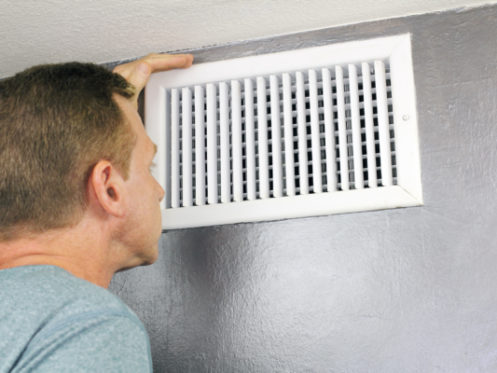When temperatures drop during the cold months, the best way to warm your home is by cranking up your furnace. Your heating system makes your entire house well-heated and comfortable for all occupants. But what happens when you fire up your heating appliance, and it starts blowing cold air?
If your furnace expels cold air, this can be stressful, especially in areas where the temperature gets below the freezing point. When this happens, get in touch with our team of professionals immediately to help you fix the issue quickly and effectively. Below are some possible reasons why your furnace is emitting cold air.
1. Leaking or Damaged Ductwork
Your furnace sends conditioned air throughout your house via a system of ducts behind your walls. If there are cracks, holes, or other damages in your ductwork, this will lead to cold air emissions in your home despite having a properly functioning furnace. Any opening in your ductwork allows hot air to leak before reaching the vents while letting cold air enter the ducts from the attic and other surroundings. When this happens, your heating appliance will emit slightly warm or cold air instead of hot air.
If your heating appliance is in good working condition but sends cold air into your house, have an experienced technician inspect the entire system and pinpoint the problem areas. The best way to deal with leaky ducts is to seal them to prevent the loss of conditioned air. We have the right tools for the job, so we’ll identify and seal every crack in your ductwork. Note that damaged ducts also make your furnace more inefficient and may cause more problems to your unit, so you need to call our team as soon as possible.
2. Thermostat Set Incorrectly
Your thermostat makes it easier to set a temperature range that is ideal for your household’s comfort. So, when your furnace starts blowing cold air, this should be one of the first places to check. You may have unintentionally changed the temperature settings, especially when seasons change during the hot months that you barely need your furnace.
Make sure the thermostat isn’t toggled to the ‘on’ setting. This setting makes the fan on your heating unit continually run throughout the day, even when your equipment isn’t actually on. Set your thermostat to ‘Auto’ so the fan and the furnace run at the same time when you need heat in your home.
3. Damaged Pilot Light
If you still use the same home furnace you bought about 20 years ago, it most likely has a pilot light. This small gas light burns continuously, so the larger burner can ignite when needed. However, a pilot light may be distinguished due to a dirty valve or a strong draft, especially when you don’t use your furnace for several months, like during the summer. If the pilot light is out, your heating system won’t produce heat.
You can rely on our experienced professionals to assess your equipment and confirm whether the pilot light is out. We will then locate the pilot assembly and the reset toggle at the bottom of the heating unit. Making proper adjustments to the reset toggle to align with the pilot setting will relight the pilot light.
4. Low Gas Supply
Your furnace relies on a constant gas supply to the burners to generate hot air. In case the gas supply is off or insufficient, your heating unit won’t function steadily, leading to the production of cold air. This issue may result from a dysfunctional gas entry valve or an empty fuel tank.
You can check if other gas appliances in your house are receiving enough gas supply, such as the gas oven. This will confirm whether the gas supply issue affects your entire home or the furnace only. If just the heating system has a weak or no gas supply, call our professional to perform a gas repair project. Note that gas supply issues can endanger the lives of your loved ones, so always seek assistance from our experts.
5. Dirty Filters
Over time, the dirt and debris generated in your home find their way into the vents and clog the air filters. When the air filters get overly clogged, there is limited airflow to your heating system. This may cause your furnace to overheat and then turn off.
To avoid this problem, ensure your air filters are cleaned or changed regularly, especially after the summer when you don’t use the furnace. Make sure you involve a qualified professional to help you remove the filter from the air handler. Changing your furnace filter every 90 days also prevents the heat exchanger from possible damage.
6. Thermostat Not Working
While your thermostat setting is usually the first place to check when your furnace doesn’t produce hot air, other thermostat problems could be the issue. If your thermostat isn’t working correctly, it doesn’t communicate your desired home’s temperature needs to your heating system. This can result in your furnace blowing cold air because it doesn’t receive proper instructions from the malfunctioning thermostat. The missing directions could be caused by a wiring issue or an incompatible thermostat, especially if the installation wasn’t done by a professional.
Call our technicians for assistance if you suspect that a thermostat issue makes your unit blow cold air. Replacing the faulty thermostat will ensure accurate communication with your home’s heating appliance and stop it from emitting cold air.
7. Overheating Furnace
Your furnace can also blow cold air when it overheats. Since heating units have several moving parts, a mechanical failure can happen anytime, especially if you have an older appliance. One of the most common culprits for an overheating furnace is a malfunction in the system. Older units also increase the possibility of overheating because many parts may wear out, especially if you don’t schedule preventative maintenance. Dirt buildup can also cause overheating when the dirt reaches critical parts, such as the blower.
When your furnace overheats, it will automatically shut down thanks to the safety mechanism. This prevents the unit from causing a fire, an explosion, a carbon monoxide leak, or an eventual break down. When the safety switch shuts off your heating unit, it will blow cold air before turning off. When this happens, call our team to do a thorough assessment of your furnace to know what’s causing the overheating and to find the best solution.
Your Trusted Furnace Services by the Professionals
Any homeowner dreads having a furnace that emits cold air when temperatures have dropped tremendously. This will lead to an uncomfortable home for you and your family and can also endanger your lives.
If your heating system starts blowing cold air, seek professional assistance from the right experts at Environmental Heating & Air Solutions. Our team will respond to your call within the shortest time possible, diagnose the issue, and offer the most effective solution to guarantee long-term results. We’ve been offering our customers quality services for over a decade now and always aim to exceed their expectations. Also, our company has BPI and NATE certifications, so you have peace of mind that you are working with a team that will deliver quality services.
Our comprehensive services include heating repair, carbon monoxide detection, AC inspection, home insulation, air ventilation, heating installation, water leak detection, AC installation, Air sealing, heating maintenance, water heater installation, home automation, and AC repair in Roseville. Contact Environmental Heating & Air Solutions today to book a service with our professionals.

